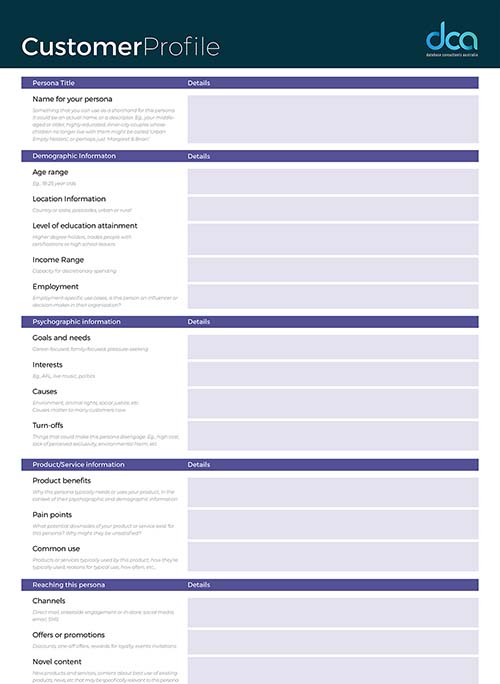Customer profiling: what is it and how do you do it?
Customer profiling, also called consumer profiling (or donor profiling in the non-profit space), is the process of collecting and analysing data to create personas. It’s a way to use data to understand customers and conceptualise the needs and wants that drive your sales.
The concept underpinning customer profiling is relatively straightforward: people who want the same products and services have things in common and they can be grouped accordingly. By doing so, businesses are empowered to message desired customers in a way that displays understanding of their needs. Knowing more about your customers allows you to tailor your product or service to what they need: you know where to focus your attention, they have a better experience, you reduce customer churn, reduce cost and raise ROI on your marketing.
So far so good!
But how do you actually use this powerful tool?
Begin with your Data
Marketing practices like customer profiling are not possible without data. The data has to come from somewhere. Sometimes this is newly commissioned market research, but we would recommend beginning with your own existing customer data. It’s a valuable resource, and it’s free for you to use.
You will always have some information about your existing customer interactions. At a minimum, you probably know how much they spend per transaction, and what products or services are usually bought together. That’s valuable information. But you’re probably also getting other details: things like delivery post codes, names, or purchase histories over time.
You can group common data points together to build the beginning of a profile. When your profiles are complete, you can turn them into personas, and use these customer archetypes as a framework through which to direct your marketing.
Example: A company provides a virtual collaborative workspace software solution. Assessing their existing data, they’ve discovered that a lot of email addresses have ‘edu’ in them.
This tells them that many of their customers might be schools—and if so, they can create a package highly attractive to the education sector to maximise their relevance to these customers.
But not all of their customers have provided professional emails: some are generic personal emails and a business address. It’s clear that they are selling to schools, but it’s hard to say if schools comprise their major market.
Extrapolate from the data you have
When creating a customer profile, consider not just the demographic information you may have but also higher context information that you can extrapolate: things like your customers’ motivations or goals and, critically, what benefit the product or service provides this type of person and what might leave them unsatisfied. This information provides a lens through which to explore consumer interactions.
Answer questions like:
- What problem are they solving with your service or product?
- Why are they choosing your service or product over a competitor’s?
- What’s the most common way they use your service or product?
Listen to your customer feedback
Your collected data is a vital part of the picture, but your customers are a valuable resource for profiling too.
Use feedback processes to make sure relevant information, such as pain points, use cases, or accessibility concerns, makes its way into your customer profiling and personas, not just your business processes.
This sort of high-context data can be more subjective than demographic information. Your experienced sales and customer service staff could be an invaluable resource for insights into different customer profiles.
Paying close attention to customer feedback has the additional effect of improving your relationship with your customers.
Build your personas
A persona is a customer archetype. It’s a very typical example of one particular kind of customer that your business sees frequently. The persona includes all the traits that, grouped together, make up the group of customers it represents.
More fleshed-out, complete personas provide more direction. Consider the following data points for inclusion:
- Demographic data like a person’s age, gender, or educational background
- Organisation data like company size and technology stack, job roles, industry, geographic location or income range
- Psychographics like goals, interests, motivations, and challenges
- How often, by what means, and why they might use your product or service
- The best ways to reach them—this might mean communication channels, or it might mean promotions or specific content that appeals to them
- Give each persona a title. It doesn’t have to be special or catchy, but you should be able to use it to refer to this persona—a shorthand for one kind of customer
You should be able to arrive at a dot-point list of good messaging ideas for this persona, how to contact them, and what they might be most interested in hearing about.
Filling in the blanks
Despite the best of efforts, missing information can leave attempts at customer profiling dead in the water. It’s not always easy to extract this data from your customers themselves, and it can be very challenging to get it from your leads in the absence of a strong, existing relationship.
Despite the challenge, you still need to know where your customers and leads fit into your data so you can assess them, either as a data point informing your profiling, or to fit them into an existing persona to keep your messaging to them consistent and relevant.
Example: In our example using the software company, business addresses need to be linked back to industries. The use-case of the software solution for education is different—and many industries have different needs, regulatory landscapes and challenges that drive them to seek solutions. The company would benefit from enriching their data with industry codes that can give them a better picture of their existing customers and potential leads.
Profiling is iterative, not static
Once your personas are developed, they can’t be static. They should be able to shift and change alongside your customers, whether that means changing in response to challenges in the financial or regulatory landscapes, or a global crisis.
Example: If our software company’s customer profiles for virtual collaboration software hadn’t been updated since 2019, they would not have been able to take full advantage of the explosion of interest in this kind of tool that came about during the covid-19 pandemic.
The world changes around us daily, and so too do the needs and goals of our customers.
For more help with profiling and personas, download the PDF of our customer persona template here.


